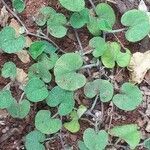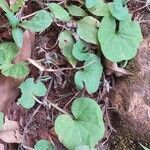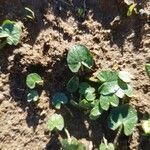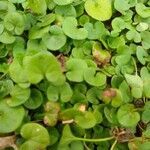Herbs perennial. Stems prostrate, freely branching, sparsely pubescent, rooting at nodes. Petiole 2-3.5 cm; leaf blade reniform to nearly circular, 0.8-1.5(-2.5) cm in diam., abaxially sparsely appressed pilose, adaxially glabrous. Pedicel erect, shorter than petiole, sharply recurved apically. Calyx broadly campanulate; lobes obovate-oblong to spatulate, 1.5-2 mm, becoming enlarged to 2.5 mm, margin densely pubescent. Corolla yellow, ca. 2 mm, 5-lobed to middle, glabrous. Stamens equal. Ovary pilose. Styles free, slightly unequal. Capsule subglobose, 2-2.6 mm, membranous, sparsely pubescent. Seeds yellow to brown, glabrous. 2n = 24*, 30.
Pubescent, procumbent herb. Stems up to 0.5 m long, shortly hairy, rooting at nodes. Leaves cordate-orbicular to reniform, 4-25 mm in diameter, base of lamina broadly cordate, apex broadly rounded or emarginate, ±7-nerved at base, upper surface glabrescent, lower surface hairy; petiole hairy, 8-70 mm long. Pedicels hairy, 2-19 mm long. Sepals 2-3 mm long, hairy on back and margins. Corolla ± as long as calyx, greenish yellowish. Capsule 1.5-2.5 mm in diameter, pilose. Seeds subglobose, minutely granular, brown.
Perennial herb, appressed-pubescent. Stems procumbent, rooting at nodes. Leaves with blade reniform to cordate-circular, 4-25 mm in diameter, base broadly cordate, apex rounded to emarginate, margin entire, upper surface glabrescent, lower surface hairy; petioles 8-70 mm long. Flowers: solitary, axillary, pedicellate; styles 2, inserted between ovary lobes; calyx lobes 2-3 mm long, hairy on back and margins; corolla ± as long as calyx, greenish yellow; Sep.-May. Fruit 1.5-2.5 mm in diameter.
Pubescent, procumbent herb. Stems up to 0.5 m long, rooting at nodes. Leaves cordate-orbicular to reniform, 4-25 mm wide, base broadly cordate and ± 7-nerved, apex broadly rounded or emarginate, upper surface glabrescent; petioles 8-70 mm long. Pedicels 2-19 mm long. Sepals 2-3 mm long. Corolla as long as calyx, yellow-green. Flowering time Sept.-May. Fruit a 1.5-2.5 mm wide capsule. Seeds subglobose, minutely granular, brown.
Hairy, creeping, rhizomatous perennial to 5 cm. Leaves reniform. Flowers white.
A herb.





